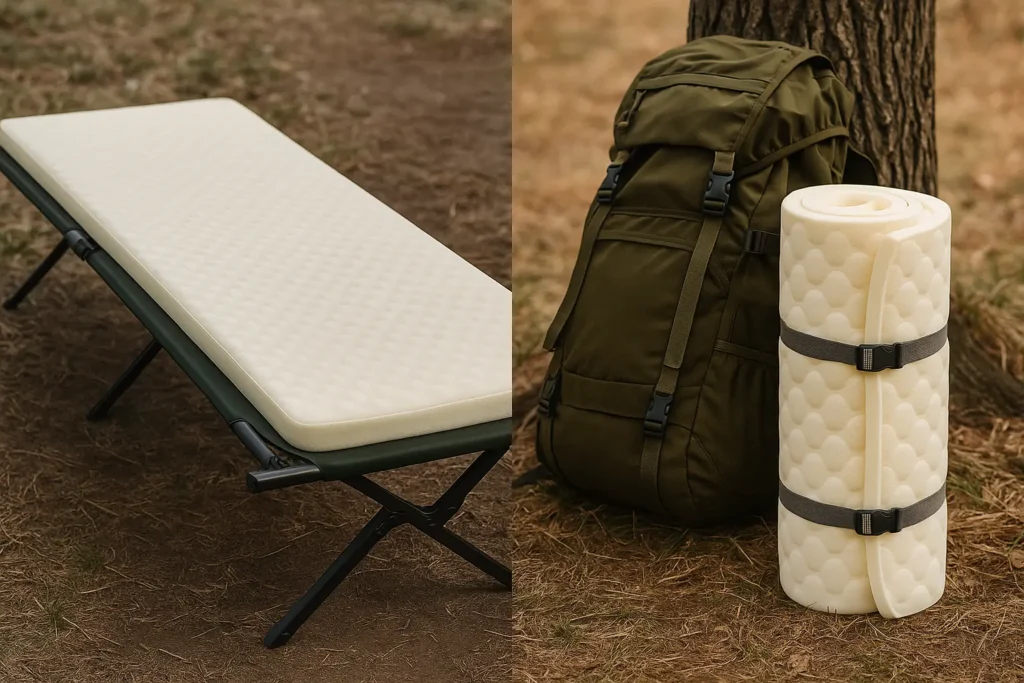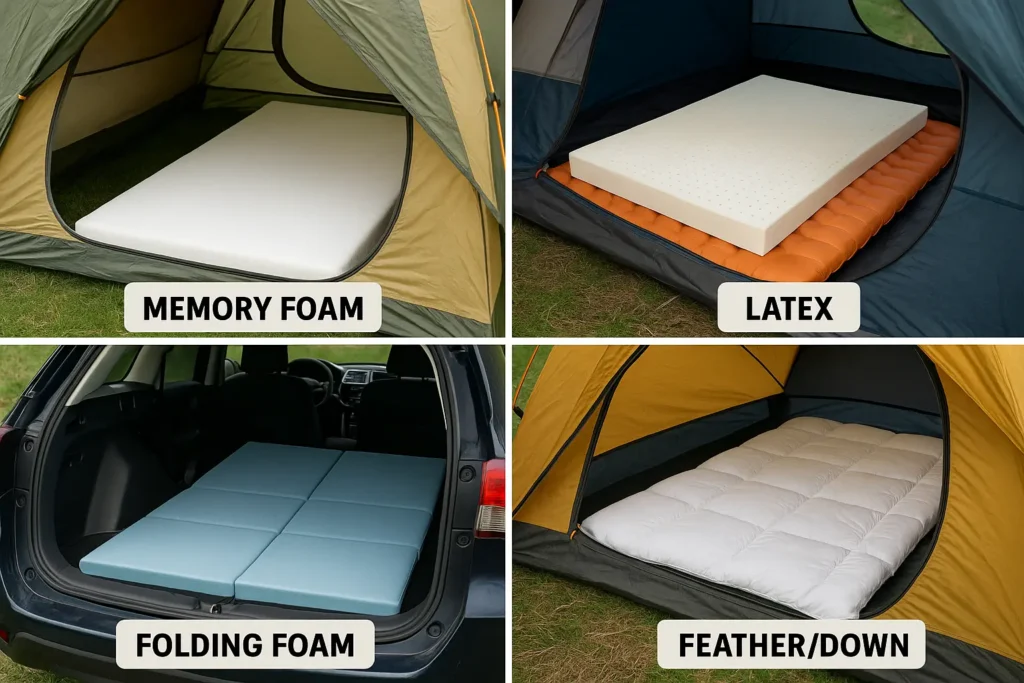Can you use a mattress topper for camping? I used to ask the same thing. Camping is amazing—until it’s time to sleep on hard, uneven ground. That’s when I brought a mattress topper on a trip, and honestly, it made a world of difference.
Whether you’re in a tent, on a camping cot, or trying out car camping, the right foam mattress topper or portable sleeping pad can seriously upgrade your comfort. After years of camping across the Pacific Northwest, I’ve found toppers to be one of the easiest ways to improve outdoor sleep.
In this guide, I’ll share the pros, the cons, how to protect and clean your topper, and which types work best—so you can rest easy under the stars.
This article contains affiliate links. If you purchase through these links, I may earn a small commission at no extra cost to you, helping support my work. My recommendations are based on personal experience and thorough testing. Read my full disclosure for details.
What is a Mattress Topper?
A mattress topper is basically a 2–4 inch layer of extra padding—usually made from memory foam, latex, or foldable foam—that you lay on top of your sleeping surface for extra comfort. In a camping setup, it works great over tent floors, camping cots, or even the back of a truck bed. Unlike air mattresses for camping that can deflate overnight, or thin sleeping pads that focus on insulation, mattress toppers are all about cushioning and support. They’re especially popular in car camping or glamping setups where a little extra bulk is no big deal.

Types of Mattress Toppers for Camping
Not all mattress toppers are created equal—especially when you’re sleeping outdoors. Depending on your camping style, weather conditions, and how much space you’ve got, the right topper can make all the difference. Here are the main types campers usually go for:
- Memory Foam: Super comfy and molds to your body for that “just right” feel. I love it for summer trips, but it can stiffen up when the temps drop below 40°F—so maybe skip it for winter camping.
- Latex Foam: A bit firmer, but more breathable and holds up great in hot, humid weather. Plus, it’s naturally more durable, which makes it a solid long-term option.
- Folding Foam: This one’s perfect for car camping or short trips. It’s lightweight, compact, and easy to fold up and toss in your trunk. Great if you want comfort without the bulk.
- Feather/Down: Super soft and luxurious—feels like a cloud—but not ideal outdoors. It’s bulky, and once it absorbs moisture, drying it out is a pain. More of a glamping pick than a backcountry one.

Is a Mattress Topper Worth It?
Honestly? It depends on what kind of camper you are. If you’re someone who values a solid night’s sleep and you’re not ultra-focused on packing light, then yes—a mattress topper can absolutely be worth it. The added comfort, support, and ease of use can take your camping experience to another level.
That said, it’s not for everyone. If you’re a backpacker, dealing with limited space, or heading into wet, rugged terrain, a sleeping pad might make more sense. It really comes down to your priorities: comfort vs. portability, warmth vs. cushion.
In my experience, for car camping, glamping, or longer base camp setups, a topper is a no-brainer. Just make sure you understand the trade-offs, and take care of it—especially when it comes to moisture and storage.
- If waking up refreshed matters more than packing ultralight, a mattress topper is a smart, cost-effective way to level up your outdoor sleep setup.
Benefits of Using a Mattress Topper for Camping
Bringing a mattress topper on a camping trip might seem extra at first—but once you try it, there’s no going back. Whether you’re out in the woods for a weekend or on a longer overlanding trip, a topper adds a layer of comfort and practicality that truly changes the game. Here’s why so many campers (myself included) swear by it:
Enhanced Comfort and Support
During a weeklong trip in Oregon’s Deschutes National Forest, I laid my 4-inch version of the Zinus Green Tea Memory Foam Topper right over some rocky terrain and I slept better than I ever did on an air mattress. Unlike inflatables that deflate or sag overnight, mattress toppers provide consistent support, especially on uneven ground. If your back has ever hated you after a night in the tent, this fixes that.
Lightweight and Portable
You’d think something this comfy would be bulky—but that’s not always the case. Folding foam toppers like the Milliard Tri-Fold Memory Foam Mattress are surprisingly travel-friendly. They weigh around 10–15 lbs and fit easily in a car trunk or rooftop tent. I’ve used mine on several road trips, and it’s held up great.
Insulation: A Warm Layer Between You and the Ground
Camping in colder seasons? A good foam mattress topper does more than just cushion—it helps insulate. I’ve used mine on chilly autumn nights and felt way warmer than with a basic sleeping pad. It blocks ground chill and gives your body a fighting chance at staying cozy all night.
Versatility Across Camping Styles
One thing I love about toppers? They adapt. I’ve thrown mine on camping cots during family trips, used it in truck beds while overlanding, and even laid it in rooftop tents during solo getaways. They’re also a great option if you’re trying to sleep comfortably in your car while camping. Whether you’re glamping or roughing it, they fit in almost any setup.
Budget-Friendly Comfort
Let’s be real—not everyone wants to drop big bucks on fancy gear. Luckily, mattress toppers are a cost-effective solution. Most range between $50–$150, and they usually outlast the cheap air mattresses that puncture after a few uses. It’s a one-time buy that pays off with every restful night.
Drawbacks of Using a Mattress Topper for Camping
As much as I love using a mattress topper for camping, I’ll be real—it’s not perfect for every trip. There are a few things you’ll want to think about before packing one along. Here’s what I’ve learned from experience:
Not Built for the Elements
Most mattress toppers aren’t made for outdoor conditions. If you’re camping somewhere damp or humid, foam toppers can soak up moisture pretty quickly. After a rainy weekend in Washington’s Olympic Peninsula, I had to leave mine out in the sun just to keep mildew at bay. Pro tip? Use a waterproof cover or ground tarp underneath—it helps a lot.
Temperature Sensitivity
Some toppers just don’t handle cold well—especially memory foam. I took my usual summer topper on a late fall trip to Glacier National Park in Montana, and it turned stiff as a board by midnight. If you’re camping in varying climates, latex or folding foam toppers tend to be more reliable.
Bulk and Storage Issues
Even when folded, a queen-size topper can take up half the backseat of your car. If you’re short on space or traveling in a smaller vehicle, it becomes a bit of a headache. For backpackers or minimalist campers, traditional sleeping pads are usually the smarter move.
Limited Insulation in Cold Weather
While mattress toppers can indeed introduce an extra layer of comfort to your camping experience, it’s essential to consider the flip side of the coin as well. As with all things, mattress toppers for camping have their fair share of drawbacks.
So yeah, a topper can seriously improve comfort—but it’s not always the best tool for every type of camping trip. Weigh the pros and cons, and if you’re heading into tougher conditions, consider mixing it with other gear for the best sleep possible.
Exploring Alternatives: Beyond Mattress Toppers
While mattress toppers can seriously improve your sleep, they’re not the only option out there. Depending on your setup and what kind of camping you’re doing, one of these might be a better fit:
- Inflatable Mats: Lightweight, portable, and quick to inflate. Good for backpackers or anyone who’s tight on space but still wants a bit of cushion.
- Blankets: Not just for warmth—thicker blankets can be folded and used for padding too. Plus, you’ve probably already packed one.
- Camping Mattresses: These are built specifically for the outdoors and offer great support. A bit bulkier, but worth it for longer stays or base camps.
- Sleeping Pads: Often self-inflating and super light, these are ideal for minimalist campers. Some even have decent R-values for insulation in colder weather.
- Multipurpose Foam Pads: Think gym mats or yoga-style pads that can double up as a seat during the day. They’re durable, easy to clean, and surprisingly useful around camp.
Tips for Using a Mattress Topper While Camping
Drawing from years of trial and error, these tips will help you get the most from your mattress topper for camping:
Choose the Right Thickness
A 4-inch topper strikes the perfect balance for comfort and portability. Thicker options (5-6 inches) feel luxurious but are harder to transport, while thinner ones may not cushion rocky ground well.
Use a Waterproof Cover
A waterproof mattress cover protects against spills, dew, or rain. I use the Utopia Bedding Waterproof Mattress Protector on every trip—it’s machine washable, breathable, and holds up well even after muddy nights.
Pair with a Sleeping Pad
For insulation and extra protection, place a tarp or high-R-value sleeping pad beneath your topper. This combo kept me warm and comfortable on a snowy camp in Colorado’s San Juan Mountains.
I’ve paired my topper with the Therm-a-Rest BaseCamp Sleeping Pad, which adds insulation without adding much bulk. It’s especially useful when temps dip unexpectedly.
Store Properly
Roll your topper tightly with straps for transport. Post-trip, air it out in sunlight to prevent moisture buildup. I store mine in a dry garage to extend its lifespan.
For easy transport, I recommend the REDCAMP Stuff Sack with Straps—it compresses the topper and keeps it secure during travel.
Test at Home
Sleep on your topper indoors for a night to ensure it meets your comfort needs. This saved me from bringing an overly firm topper on a weeklong Yosemite trip.
FAQs About Using Mattress Toppers for Camping
Conclusion
If you care about a good night’s sleep in the wild, then yes—a mattress topper for camping is absolutely worth it. It adds serious comfort, whether you’re in a tent, truck bed, or rooftop setup. From memory foam to folding foam, the right topper can beat air mattresses when it comes to consistency and support—no more sagging or deflating in the middle of the night.
We’ve looked at the pros and cons, real-world usage, cleaning tips, and everything in between. For car camping, glamping, or extended trips, a quality foam mattress topper paired with a waterproof cover can make all the difference in your camping sleep setup.
Just remember to choose one that fits your gear and conditions, and check reviews before buying.
